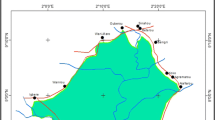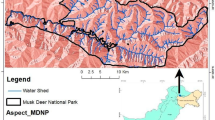Abstract
The study attempts quantitative assessment of the use value of traditionally used woody species in a representative mid-Himalayan watershed of west Himalaya. Ethnobotanical surveys were conducted in the fringe villages of altitudinally diverse forested area of the watershed covering different age group respondents. A total of 34 woody species (27 trees and 7 shrubs) belonging to 25 families were identified as useful in the watershed, and their availability varied considerably across the altitudes. The relative frequency citation and use value for each identified species were analysed. Further, vegetation surveys were conducted in nearby forests to assess the availability of identified useful species. Outcomes of this study can be used to develop an effective augmentation plan for the community forests within the watershed and other Himalayan forests.

Source: KSLCDI Project-2015



Similar content being viewed by others
References
Ahmed J, Sharma S, Kumar D (2016) Quantitative ethno botanical approach to analyze local importance of tree species in North Western Himalaya: a case study of Ponda Watershed, J&K. Proc Natl Acad Sci India Sect B Biol Sci 1:1. https://doi.org/10.1007/s40011-016-0828-6
Albuquerque UP, Araujo TAS, Ramos MA, do Nascimento VT, de Lucena RFP, Monteiro JM et al (2009) How ethnobotany can aid biodiversity conservation: reflections on investigations in the semi-arid region of NE Brazil. Biodivers Conserv 18:127–150
Albuquerque UP, Soldati GT, Sieber SS, Medeiros PM, Caetano de Sa J, de Souza LC (2011) Rapid ethnobotanical diagnosis of the Fulni-ô Indigenous lands (NE Brazil): floristic survey and local conservation priorities for medicinal plants. Environ Dev Sustain 13:277–292
Aldieri L, Vinci CP (2017) The role of technology spillovers in the process of water pollution abatement for large international firms. Sustainability 9(5):868
Amjad MS, Arshad M (2014) Ethnobotanical inventory and medicinal uses of some important woody plant species of Kotli, Azad Kashmir, Pakistan. Asian Pac J Trop Biomed 4(12):952–958
Arshad M, Ahmad M, Ahmed E, Saboor A, Abbas A, Sadiq S (2014) An ethnobiological study in Kala Chitta hills of Pothwar region, Pakistan: multinomial logit specification. J Ethnobiol 10(1):13
Bhatt D, Chandra Sekar K, Rawal RS, Nandi SK, Dhyani PP (2016) Tree diversity of Western Himalaya. G.B Pant Institute of Himalayan Environment and Development, Almora
Bhattarai KR, Acharya SK (2015) Documentation of ethnobotanical knowledge of Tharu people on the utilization of plant resources in Gadariya and Phulwari VDCs of Kailali district, West Nepal. Bull Dept Pl Res 37:41–50
Bisht AK, Bhatt A, Rawal RS, Dar U (2006) Prioritization and conservation of Himalayan medicinal plants: angelica glauca Edgew. as a case study. Ethnobot Res Appl 4:11–23
Dhar U, Rawal RS, Upreti J (2000) Setting priorities for conservation of medicinal plants—a case study in the Indian Himalaya. Biol Conserv 95:57–65
Hájek P, Stejskal J (2018) R&D cooperation and knowledge spillover effects for sustainable business innovation in the chemical industry. Sustainability 10(4):1064
Janni KD, Bastien JW (2000) Establishing ethnobotanical conservation priorities: a case study of the Kallawaya pharmacopoeia. SIDA 19:387–398
Kala CP, Farooquee NA, Dhar U (2004) Prioritization of medicinal plants on the basis of available knowledge, existing practices and use value status in Uttaranchal, India. Biodivers Conserv 13(2):453–469
Misra R (1968) Ecological work book. Oxford & IBH Publishing Company, Calcutta, p 242
Muller-Dombois D, Ellenberg H (1974) Aims and methods of vegetation ecology. Wiley, New York, p 547
Negi VS, Pathak R, Sekar KC, Rawal RS, Bhatt ID, Nandi SK, Dhyani PP (2017) Traditional knowledge and biodiversity conservation: a case study from Byans Valley in Kailash Sacred Landscape, India. J Environ Plann Man 1:1. https://doi.org/10.1080/09640568.2017.1371006
Oliveira RLC, Lins Neto EMF, Araujo EL, Albuquerque UP (2007) Conservation priorities and population structure of woody medicinal plants in an area of Caatinga vegetation (Pernambuco state, NE Brazil). Environ Monit Assess 132:189–206
Pandey A, Sekar KC, Joshi B, Rawal RS (2018) Threat assessment of high-value medicinal plants of cold desert areas in Johar valley, Kailash Sacred Landscape, India. Plant Biosyst 153:1–9. https://doi.org/10.1080/11263504.2018.1448010
Pangtey YPS, Samant SS, Rawat GS (1988) Contribution to the flora of Pithoragarh District (Kumaun Himalaya). Himal Res Dev 7:24–46
Phillips O, Gentry AH, Reynel C, Wilkin P, Galvez Durand B (1994) Quantitative ethnobotany and Amazonian conservation. Conserv Biol 8(1):225–248
Purohit K, Samant SS (1995) Fodder trees and shrubs of Central Himalaya. Gyanodaya Prakashan, Nainital
Rashid S, Ahmad M, Zafar M, Sultana S, Ayub M, Khan MA, Yaseen G (2015) Ethnobotanical survey of medicinally important shrubs and trees of Himalayan region of Azad Jammu and Kashmir, Pakistan. J Ethnopharmacol 166:340–351
Rawal RS, Bhatt ID, Sekar KC, Nandi SK (eds) (2013) The Himalayan biodiversity: richness, representativeness, uniqueness, and life-support values. G.B Pant Institite of Himalaya Environment and Development (GBPIHED), Almora Uttarakhnd
Samant SS (1998) Diversity, distribution and conservation of fodder resource of west Himalaya, India. In: Proceedings of the 3rd temperate pasture and fodder network (TAPAFON), Pokhra, Nepal, sponsored by FAO Rome, pp 109–128
Samant SS, Dhar U (1997) Diversity, endemism and economic potential of wild edible plants of Indian Himalaya. Int J Sust Dev World 4(3):179–191
Samant SS, Pant S (2003) Diversity, distribution pattern and traditional knowledge of sacred plants in Indian Himalayan Region. Indian J For 26(3):222–234
Samant SS, Dhar U, Palni LMS (1998) Medicinal plants of Indian Himalaya. Gyanodaya Prakashan, Nainital
Singh SP (2007) Himalayan forest ecosystem services: incorporating in national accounting, vol 9. Central Himalayan Environment Association (CHEA), Nainital
Sop TK, Oldeland J, Bognounou F, Schmiedel U, Thiombiano A (2012) Ethnobotanical knowledge and valuation of woody plants species: a comparative analysis of three ethnic groups from the sub-Sahel of Burkina Faso. Environ Dev Sustain 14(5):627–649
Stoffle RW, Halmo DB, Evans MJ, Olmsted JE (1990) Calculating the cultural significance of American Indian plants: paiuteand Shoshone Ethnobotany at Yucca Mountain, Nevada. Am Anthropol 92:416–432
Tardio J, Pardo-de-Santayana M (2008) Cultural importance indices: a comparative analysis based on the useful wild plants of Southern Cantabria (Northern Spain). Econ Bot 62:24–39
Van Andel TR, Croft S, van Loon EE, Quiroz D, Towns AM, Raes N (2015) Prioritizing West African medicinal plants for conservation and sustainable extraction studies based on market surveys and species distribution models. Biol Cons 181:173–181
Vijayakumar S, Yabesh JEM, Prabhu S, Manikandan R, Muralidharan B (2014) Quantitative ethnomedicinal study of plants used in the Nelliyampathy hills of Kerala, India. J Ethnopharmacol 161:238–254
Vitalini S, Iriti M, Puricelli C, Ciuchi D, Segale A, Fico G (2013) Traditional knowledge on medicinal and food plants used in Val San Giacomo (Sondrio, Italy)—an alpine ethno-botanical study. J Ethnopharmacol 145(2):517–529
Wezel A, Lykke AM (2006) Woody vegetation change in Sahelian West Africa: evidence from local knowledge. Environ Dev Sustain 8(4):553–567
Yaoitcha AS, Houehanou TD, Fandohan AB, Houinato MRB (2015) Prioritization of useful medicinal tree species for conservation in Wari-Maro Forest Reserve in Benin: a multivariate analysis approach. Forest Policy Econ 61:135–146
Acknowledgements
The authors are thankful to the Director, G.B. Pant National Institute of Himalayan Environment and Sustainable Development, Kosi-Katarmal, Almora, for providing facilities and encouragement to undertake this work. We acknowledge partial funding for the study under In-House Project-7, GBPNIHESD and the Kailash Sacred Landscape Conservation and Development Initiative (sponsored by GIZ-ICIMOD).
Author information
Authors and Affiliations
Corresponding author
Rights and permissions
About this article
Cite this article
Joshi, B.C., Rawal, R.S., Chandra Sekar, K. et al. Quantitative ethnobotanical assessment of woody species in a representative watershed of west Himalaya, India. Energ. Ecol. Environ. 4, 56–64 (2019). https://doi.org/10.1007/s40974-019-00114-9
Received:
Revised:
Accepted:
Published:
Issue Date:
DOI: https://doi.org/10.1007/s40974-019-00114-9




